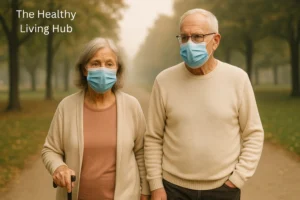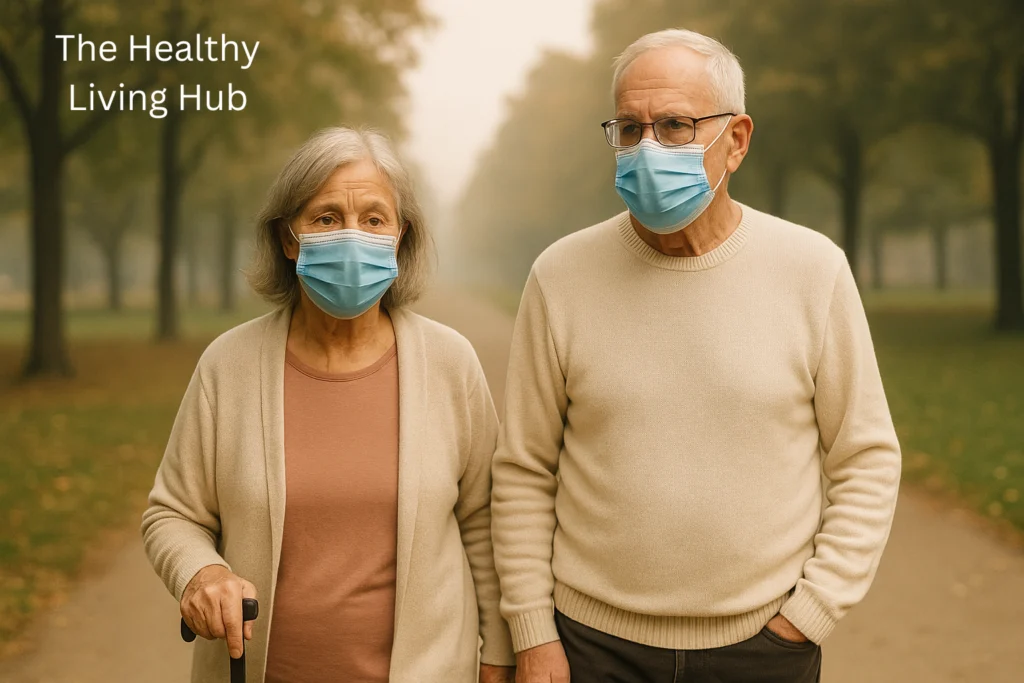Growing evidence shows that Air Pollution Frailty Risk is a serious public health concern. A major new study has revealed that long-term exposure to polluted air increases the risk of frailty in older adults by 19%. This means people living in areas with high air pollution may experience faster aging, weaker physical resilience, and a higher likelihood of health complications as they grow older.
Frailty is not just “getting old.” It’s a condition marked by reduced strength, mobility, and resistance to stress — increasing vulnerability to illness and disability. Understanding how air pollution drives this risk is essential for both individuals and policymakers in the US and UK.

What Is Frailty — and Why It Matters
Frailty is a medical term used to describe a decline in physiological reserves and resilience, especially among older adults. It is often measured through tools like the “frailty index,” which evaluates factors such as mobility, weight, strength, and energy levels.
People with frailty are at higher risk of falls, hospitalizations, chronic diseases, and even premature death. Importantly, frailty is not inevitable — it can be prevented or delayed through healthier lifestyles and environmental improvements.
This is why Air Pollution Frailty Risk matters so much: if air quality is contributing to frailty, it’s not just an environmental issue — it’s a major aging and healthcare issue too.
How Air Pollution Affects the Body
Air pollution consists of harmful particles and gases released from traffic, industry, and other human activities. The most dangerous are fine particulate matter (PM2.5) — particles so small they can enter the bloodstream through the lungs.
Long-term exposure to PM2.5 and nitrogen dioxide (NO₂) triggers chronic inflammation and oxidative stress throughout the body. Over time, this accelerates biological aging, damages tissues, and weakens organ systems, especially the cardiovascular and respiratory systems.
This constant, low-grade stress on the body is a key biological pathway linking air pollution to frailty risk.
New Research: 19% Higher Frailty Risk
The new study followed thousands of adults over time, analyzing their exposure to air pollution and their physical health outcomes. The findings were striking:
Long-term exposure to dirty air was associated with a 19% increase in frailty risk compared to those living in areas with cleaner air.
This relationship remained significant even after adjusting for socioeconomic status, lifestyle, and other health factors.
In simpler terms, breathing polluted air daily may be aging your body faster — even if you eat well and exercise.
Long-Term Exposure and the Aging Process
Frailty develops gradually. Air pollution doesn’t cause frailty overnight, but chronic exposure contributes to processes like:
Persistent inflammation
Mitochondrial damage and cellular stress
Impaired muscle function
Accelerated biological aging
These processes mirror the same mechanisms seen in age-related diseases such as heart disease, diabetes, and dementia. This semantic overlap is why Air Pollution Frailty Risk is increasingly being recognised as part of the “ageing exposome” — the total environmental exposures affecting how we age.
US & UK Data: A Growing Concern
In both the United States and United Kingdom, millions of people — especially those in urban and industrial areas — are regularly exposed to air pollution levels above recommended safety limits.
In the US, urban residents in cities like Los Angeles and Chicago face high PM2.5 levels, contributing to greater frailty risk in older populations.
In the UK, air pollution remains a top environmental threat, particularly in London and major cities where traffic congestion worsens air quality.
This geographic relevance strengthens the case for addressing Air Pollution Frailty Risk through both individual action and policy change.
Who’s Most at Risk?
While air pollution affects everyone, certain groups face higher frailty risks:
Older adults (65+) — due to naturally declining resilience.
Urban populations — exposed to dense traffic and industrial pollutants.
People with chronic diseases — heart or lung conditions worsen pollution effects.
Socioeconomically disadvantaged groups — often living in more polluted neighborhoods.
This makes Air Pollution Frailty Risk not only a medical and environmental issue but also a social equity concern.
Daily Protection Strategies
You can’t change the air overnight — but you can reduce personal exposure and strengthen your resilience. Practical tips include:
Use air purifiers indoors, especially in bedrooms.
Check daily air quality indexes and limit outdoor activity on high-pollution days.
Plant trees or maintain indoor plants, which can improve air quality over time.
Exercise in greener areas, away from traffic-heavy roads.
Wear well-fitting masks on heavily polluted days.
Support clean air initiatives in your local area.
These steps may help lower your personal Air Pollution Frailty Risk while supporting broader public health improvements.
Government & Community Role
Reducing Air Pollution Frailty Risk isn’t just about personal action — it requires strong policy measures. Governments can play a key role by:
Setting stricter air quality standards
Promoting clean transportation (electric vehicles, public transport)
Expanding green urban spaces
Investing in health surveillance for vulnerable populations
Community-level actions, such as supporting local clean-air campaigns, are equally important to reduce exposure for everyone — especially older adults.
Related Reading
For another example of how public health measures can significantly reduce disease burden, check out our article on HPV Vaccine Success: Cervical Cancer Rates Drop for Everyone—Even the Unvaccinated. It’s a powerful reminder of how environmental and preventive strategies can protect entire communities.
Conclusion: Clean Air = Healthier Aging
The evidence is clear: Air Pollution Frailty Risk is real and growing. Long-term exposure to dirty air can accelerate aging, weaken the body, and increase frailty risk by nearly 20%.
The good news is that policy changes, community action, and individual choices can make a difference. Cleaner air doesn’t just benefit the lungs — it supports stronger, healthier aging for everyone.
👉 Take action today — check your local air quality, make small daily changes, and support clean air initiatives to protect yourself and your loved ones.


Hi, this is a comment.
To get started with moderating, editing, and deleting comments, please visit the Comments screen in the dashboard.
Commenter avatars come from Gravatar.